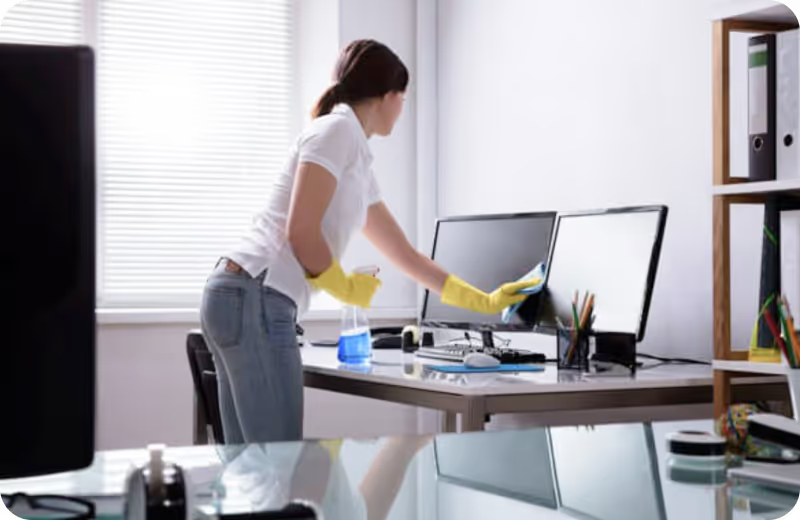.jpg)
Bathroom fixtures tend to get the vast majority of our attention when it comes to deep cleaning sessions. The shower floor and tiles, however, are just as capable of spoiling the look of your bathroom as much as an unkept toilet. In fact, the shower floor is the filthiest part of your bathroom, as it catches all the dirt and germs from flushing the toilet, and spills from sinks.
Cleaning your shower floor and ridding it of grime and dirt is a relatively easy task if you know what you’re doing. If you don’t, well you’re in the right place, because this guide tells you how to clean your shower floor tiles with minimal effort.
How to Remove Soap Scum from Shower Tiles
One of the most annoying parts of cleaning the tile showers in your bathroom has to do with removing the soap scum that’s stuck to the walls. Follow these simple instructions to help make this task a whole lot easier.
Pre-Treatment of Scum
Before you begin the actual cleaning of the shower tiles, you need to conduct some pre-treatment to make the process of removing the soap scum easier. You can start with running your shower for about 10 minutes with the temperature of the water turned up to the highest point. The hot water can help to open up the pores of the tiles and helps to loosen the stubborn particles stuck to the wall. This makes your job a lot easier going forward.
Eliminating Scum
The next step involves creating a home-made cleaning remedy to help you clear out the soap scum. You can either use a store-bought liquid at this point or create a simple water-vinegar based solution that’s ideal for removing soap scum from the bathroom walls.
To make the cleaning agent yourself, simply mix one part of vinegar solution with one part of water. Fill the liquid up in a spray bottle and spread the solution across the scum-filled walls and tiles. You can begin with the wall tiles first before you move on to the floor tiles.
Make sure to pay close and extra attention to the regions of the bathroom that are especially dirty and spray a bit of excess solution in these sections.
Once you’re done covering the length and breadth of your bathroom, you can relax for 10 minutes as you allow the solution to sink into the scummy sections and work its wonders. The vinegar in your solution will be able to loosen up all the dirt and grime that’s currently residing on your bathroom floor and walls.
If you haven’t done this in a long time and you’ve noticed that your floors and tiles are not as clean as you’d have hoped, you can consider leaving the solution for at least another half an hour. The extra time will do extra damage to the soap scum!
Once you’ve let the solution settle well, you can begin to scrub the surface of the tiles using a grout brush. If you don’t have one, an old toothbrush will also do the trick. The idea is to have a stiff scrub brush that has hard bristles as these will be more effective in scraping off the soap scum and dirt.
Grout is naturally porous in its properties, and this allows the dirt and bacteria to settle into its pores. Scrubbing the grout allows the dirt to be released from the pores and you can then wash it off the surface easily.
You’re now done with the hard part of your scum removal process. All you need to do now is to rinse the surface of the tiles with plenty of water. You can either let your shower run for about five minutes or you can use a bucket to wash away the remainder of the vinegar and scum. You don’t have to use extra hot water for this step. Just warm or lukewarm water will do.
How to Clean Shower Floor Tile
The process you need to employ to clean your shower area and floor typically boils down to the type of material applied on the floor. Shower area and floor types can be divided into three categories of shower tiles:
- Stone surface shower floors
- Fiberglass and acrylic shower floors
- Porcelain shower floors
Stone Surface Shower Floors
If you have stone tiles or stone flooring in your bathroom, you may have already noticed that scum really does a number on natural stone. This is because soap scum is able to easily penetrate the upper layers of natural stone as it is far more porous than porcelain and ceramic tiles. This means that it is very easy for stone tiles to pick up the soap lather and other minerals being generated in the bathroom.
If you let the grimy scum build on the floors of your bathroom, things can get really bad over time, and only a professional will be able to clean the bathroom after that point. We’d suggest you don’t let matter get this far and conduct some deep cleaning on your own to prevent such situations. Examples of natural stone in bathrooms include marble, travertine, granite, and limestone.
In order to clean your stone shower floor, follow these steps:
- Make sure to wipe down your shower with a towel after each use
- You can use a squeegee to remove any clingling water from the tiles and floors
- Make sure to seal and reseal regularly
- Use a non-acidic cleaner when you’re cleaning your stone shower floor. Just vinegar will not work
- You can make a non-toxic cleaner at home by mixing equal parts of rubbing alcohol and water
- Pour the solution into a spray bottle and apply it all over the stone floor
- Allow the solution to sit for 10 minutes
- Wipe it down with a soft and dry cloth
- Rinse well with water
- Wipe down the stone surface one last time until it is properly dry
Fiberglass and Acrylic Shower Floors
If you have a fiberglass or acrylic shower floor, you should opt for using non-abrasive cleaners. This is because these cleaners are gentler on these relatively sensitive surfaces and don't remove the polish. Examples of all-purpose bathroom cleaners include pine oil and a light, home-made baking soda solution. The latter especially helps to offer a bit of grit to your cleaning efforts and makes matters a lot easier on you.
If you attempt to clean your floor with an overly abraise solution, you will end up scratching the surface of your fiberglass and acrylic floor.
To clean these surfaces, you should follow these instructions:
- Pour one part of baking soda paste or solution with four parts of water
- Use a spray container or bottle to contain the cleaning solution
- Spray the solution on your bathroom floor
- Allow the baking soda solution to sit on the dirty surfaces and begin the unsettling of the dirt
- After 10 minutes, you can rinse off the solution with lukewarm water
- You can wipe the floor clean now
- Conduct one last round of rinsing of the floor as the baking soda can make the floor slippery
- After one more proper rinse of the baking soda, you can use a dry and soft cloth to wipe the floor clean
Porcelain Shower Floors
Porcelain shower floors are the epitome of luxury in your bathroom. These low maintenance tiles are a great look for any bathroom theme, aesthetic, or design. Porcelain is a relatively hardy material, and glazed porcelain tiles are easy to clean as they can withstand nearly any form of cleaning solution - even commercial-strength cleaners.
For an easy, DIY method, we’ll be using vinegar. Be sure to use distilled white vinegar instead of apple cider vinegar, as the latter can stain your tiles. The acidic properties of vinegar dissolves the soap scum and hard water stains on tiles, so your porcelain tiles will end up looking brand new!
To clean your tiles with vinegar, follow these simple steps:
- Take a spray bottle, and fill half of the bottle with distilled white vinegar, and clean water.
- Spray down your porcelain tiles with the solution, getting into the grout, and spraying liberally around the corners.
- Leave the vinegar to sit on your shower floor for 5-10 minutes, then use a soft cloth or sponge to scrub away the soap scum, mold, and hard water stains.
- Rinse the solution away with some warm water.
- Reapply the vinegar spray as needed, and repeat the process if not all soap scum has been removed the first time.
- This solution can also be used to clean shower walls, toilets, and as a preventive spray for mold growth.
Clean Shower Floor Stains
Got heavy stains on your shower floors? Don’t reach for those chemical stain removers just yet! Here are some DIY solutions to get rid of those pesky stains once and for all; be it mineral stains, hair dye, mold, or other stains!
Take note that not all stains can be removed easily. Deep-seated stains may take a few applications before they are completely removed, while scratches and etches on stone tiles may not come out at all. Depending on the nature of the stain, some stains may be permanent even when treated with industrial-strength stain removers.
For now, we’ll tackle light to moderate stains on your fiberglass, acrylic, or porcelain shower floor tiles. Natural stone tiles are finicky when it comes to stain removers, so we recommend leaving those stains for the professionals to avoid further etching or scratching your tiles. Here’s how to remove stains on floor tiles:
- Take some baking soda and hydrogen peroxide.
- Create a paste from the two ingredients, incorporating the hydrogen peroxide well into the baking soda.
- Apply a generous amount of the paste on stained areas, rubbing the paste in circular motions to avoid streaks.
- Let the paste sit until it dries, then use a soft cloth or sponge to work the powder into the remaining stain discoloration.
- Rinse your shower tiles well, and repeat the process if there are any remaining stains.
- This solution can also be used to remove stains from grout and drain.
Shower Tile Made Cleaner
The condition of one’s shower area and floor often reveals the true details behind how often a bathroom is cleaned. A tidy floor directly implies that a deep clean has been recently conducted in the bathroom, and that’s a pleasant sign for all your guests.
We hope that the guides provided above help you to maintain the tidiness of your bathroom floor, and that you’ve also managed to successfully rid yourself of scummy walls. Just remember that the trick to maintain the health of all elements of your bathroom — one of the most germ-prone locations in your home — is to clean on a regular basis. This saves you a whole lot of effort when it’s time for your monthly deep clean.
For more useful guides about home cleaning, make sure to visit our blog today!


























